This is the first article of a series on the MakAir open-source ventilator, a project that I founded with friends, which was born at the beginning of the Covid-19 pandemic in early 2020. Think of this series of articles as a ledger of all that happened and all that was created. These articles could serve as the foundation of a project reboot in future years, in the event a similar pandemic was to emerge again.
This article lays out some generalities on the MakAir ventilator & overall project, providing context and a chronology of the events, as well as a quick technical overview and a list of important project members that can be reached anytime for questions.
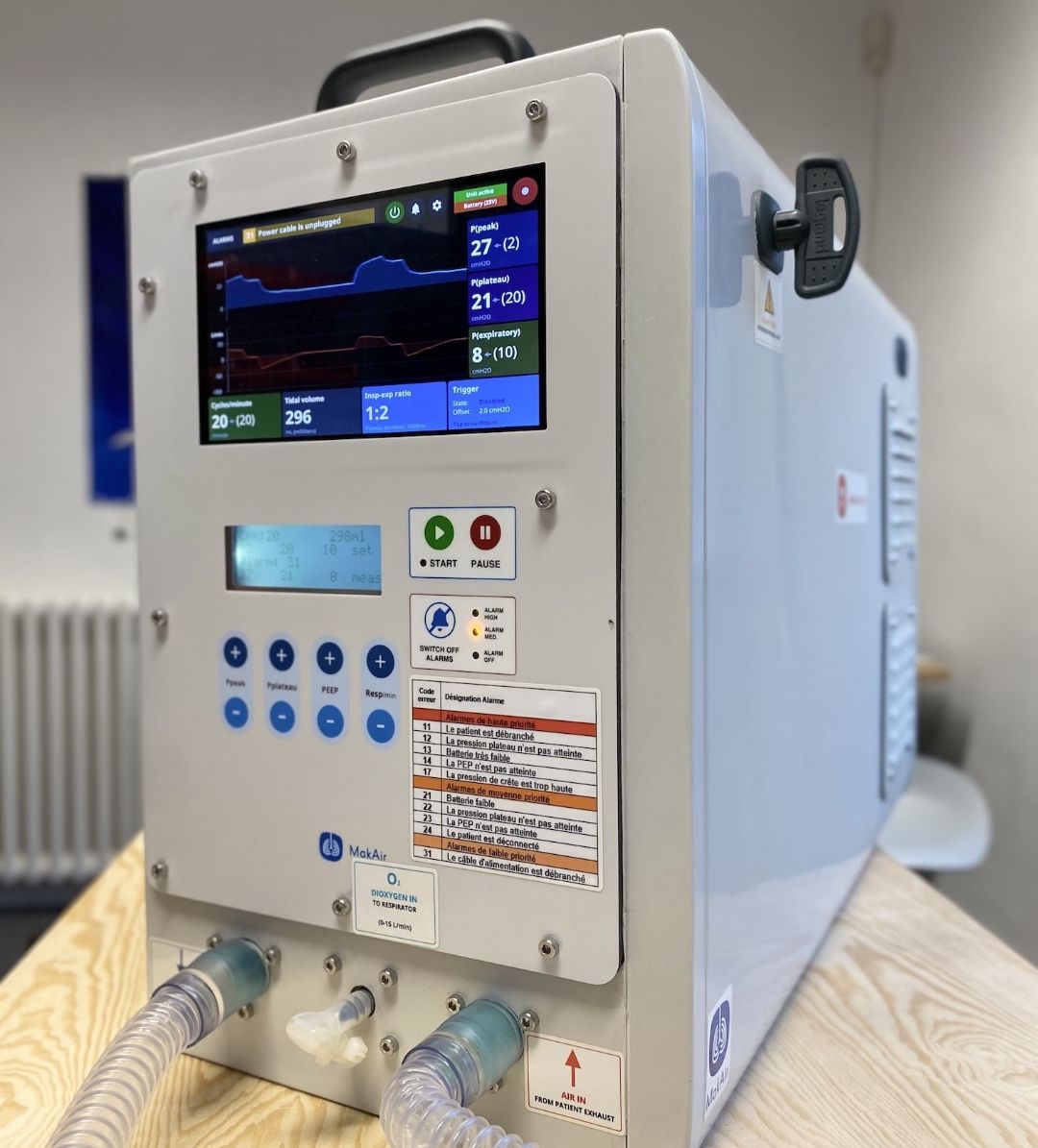
Presentation Video
If you reading this article to get a quick overview of the MakAir ventilator, you may first watch the following video, with which you will understand the basics of how a MakAir works.
Event Timeline
Back in March 2020, just 1 day before the Covid lockdown was to begin in France, I received a message from a friend of mine: “Hey! It looks like the whole world will very soon lack ventilators. You bought a 3D printer at your company a few months ago and we are all full-time software developers, what do you think about building our own open-source ventilator?”. I thought that this was crazy, but hey, let’s at least try, so I said yes.
The day after, we confined into Crisp’s offices (myself, Baptiste Jamin and Quentin Adam), and started scrambling on the foundation of what later became a much bigger and mature project, that is the MakAir open-source mechanical ventilator.
At first, it was just a simple repository on GitHub where we uploaded all our source code and CAD designs, a Telegram room where we coordinated, and a YouTube channel where we posted video updates. No strings attached.
The MakAir project gathered at its peak a whopping team of 300+ volunteers, 30 of which were on-site, working together physically, while the rest of them were providing help on anything through Slack (from Safran engineers helping with the blower fan, to designers helping build a visual identity and a website for the project).
The French army quickly responded to our funding request, literally days after the project began, and backed the project as part of its quick-response effort to help innovative projects fighting Covid-19, through its investment vehicle Agence Innovation Défense (read their announcement, in French). Then, the French Atomic Energy Commission of Grenoble stepped in and welcomed us in their high-tech facilities to further grow the project. And later, Groupe SEB joined forces by becoming our industrial manufacturer (read their announcement).
Once we had something we were confident of, we collaborated with CHU of Nantes and CHU of Brest, which are 2 large public hospitals, in order to start clinical trials on human patients. This required that we entered in a certification process with ANSM (the French FDA). Clinical trials soon started, though they are still in progress as of today. This is a super slow process, unfortunately, as you cannot shortcut medical safety even in times of crisis.
We did quite a lot of press as well, though we only pulled the trigger only when we felt confident that press coverage would not slow down the engineering side of the project. We got coverage in online press (Le Monde on 20th April 2020 or Le Point on 6th May 2020), as well as on TV news channels (TF1 on 26th April 2020 and France 3 on 21st April 2020).
All those events happened in 1 month, between March and April 2020, which is still blowing my mind today. I never thought that in time of crisis, people who are not supposed to work together could collaborate in such an efficient and unstructured way, solving a hard problem in just a few weeks. This often bring me to compare it with huge Cold War projects, like the making of the Apollo program. Put the brightest human minds in a locked underground room, with an impossible deadline and a sense of urgency; they’ll achieve incredible feats! (n.b. we were literally working 20/24h in a windowless underground room).
The project is still going on as of today, though at a slower pace. As everything is open-source (software, electronics and mechanical parts), anyone can basically reproduce, contribute and submit improvements.
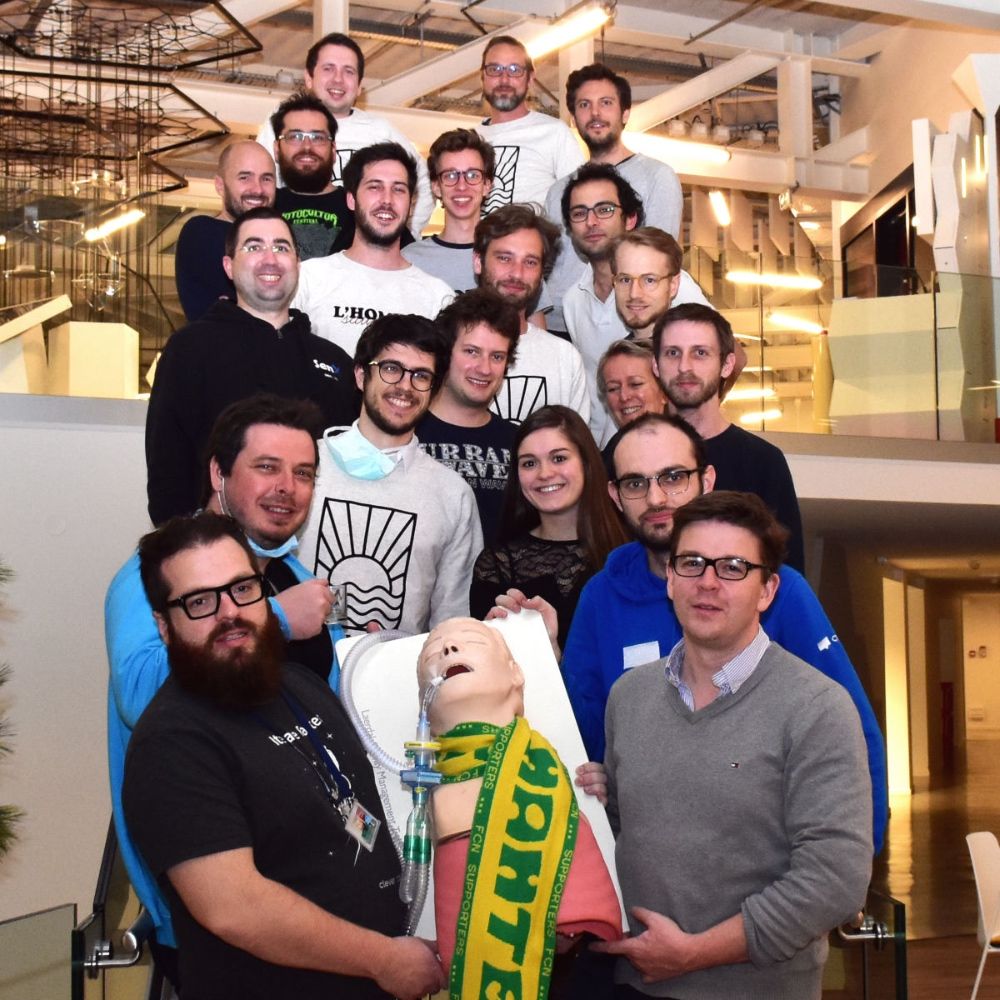
Technical Overview
This section aims at providing readers with a quick technical overview of the MakAir, with a bit of history on the design iterations that were made, as this can help understand decisions we took on the final design revision. That way readers can understand where we come from, where we are at, and where we’re going. In-depth articles on each building block of the MakAir will be written throughout the series.
First design iterations (deprecated ones)
⚠️ Disclaimer: the following designs are deprecated and do not reflect the current inner workings of the MakAir ventilator. They are only provided for context on the chronology of the project.
When we started the project, we took a first principles approach to what a ventilator is: basically a system that pushes air in and out of a patient’s lungs (respectively for the inspiratory cycle and the expiratory cycle). Knowing that, we designed a simple blower-based system pushing air through a circuit of multiple 3D-printed 2-states “1 bit” Y-shaped valves. Think of it as an air routing circuit, creating paths. Turns out that, while this worked in our experiments, we got things wrong and had to start all over. There is a presentation video of this system, in case you are interested. By the way, this design was super efficient at inflating condoms, but that’s about it. Huge leaks, high dead space in the air circuit and lack of fine control all lead to a dead-end.
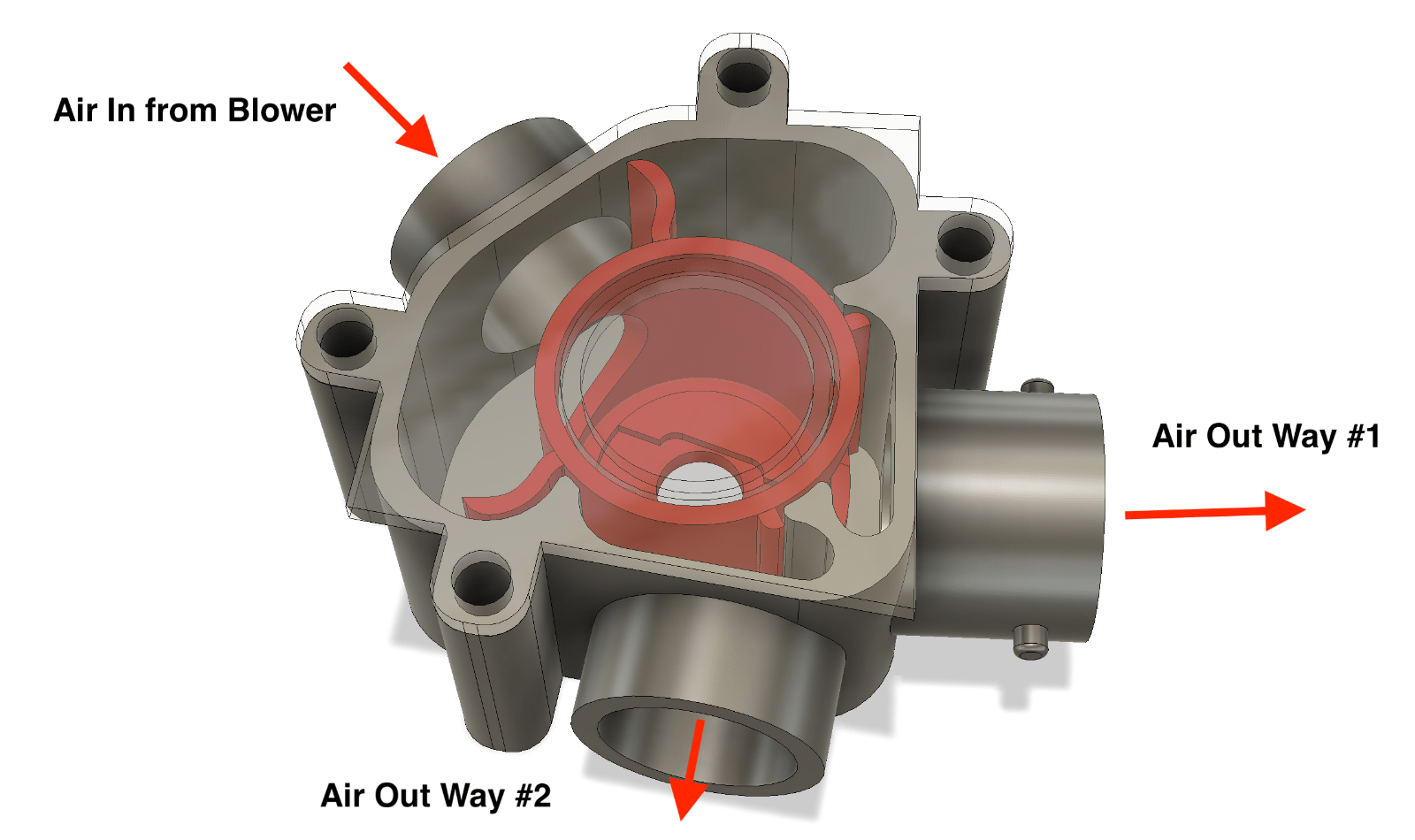

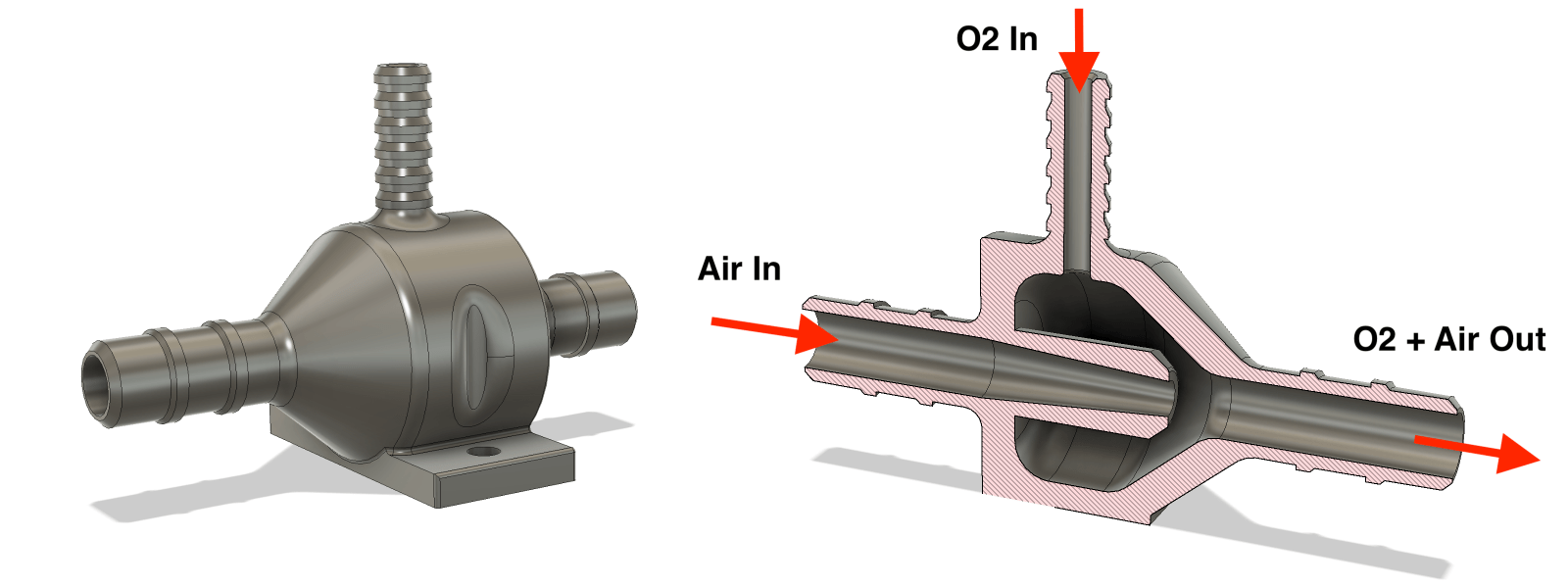
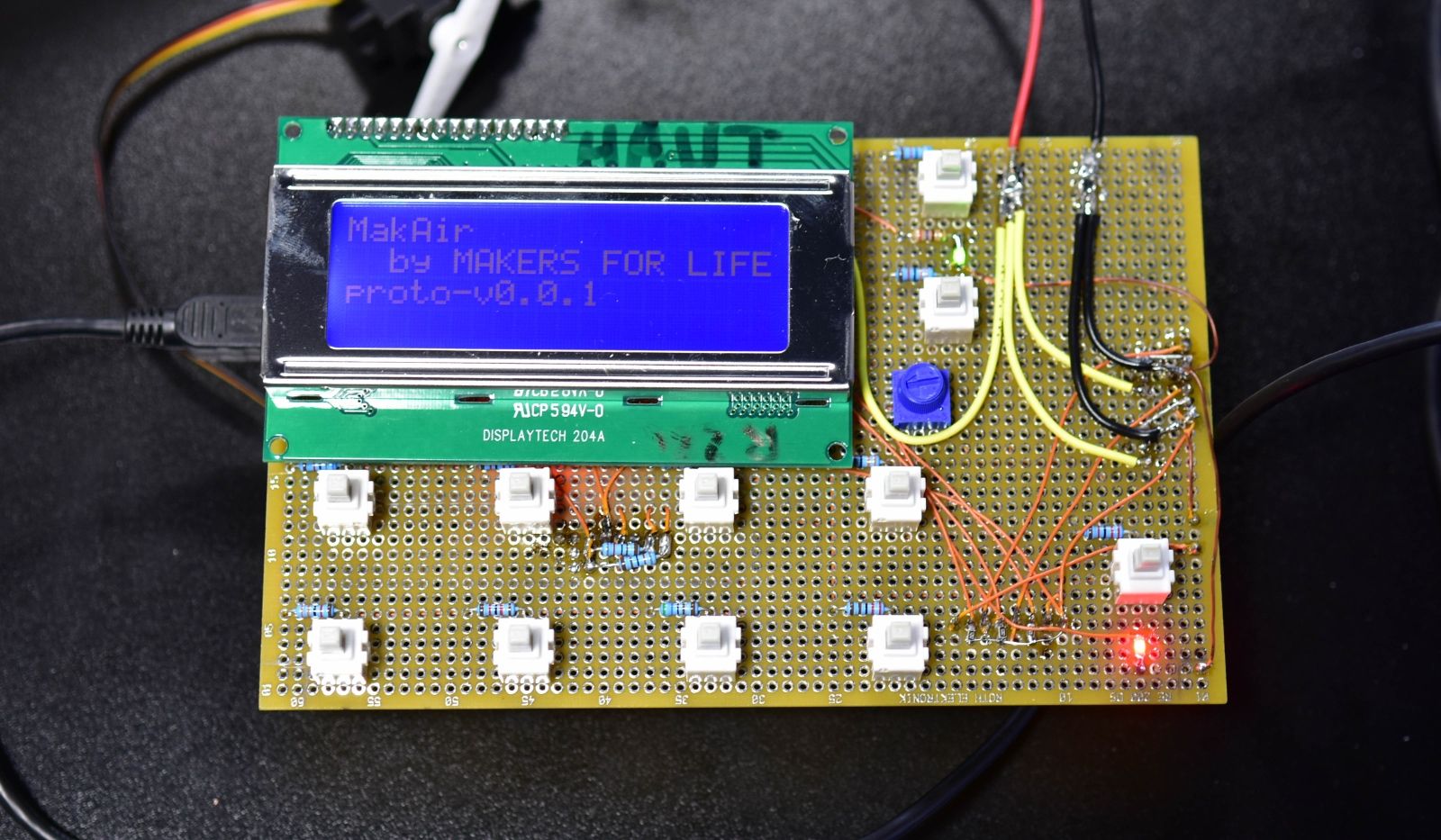

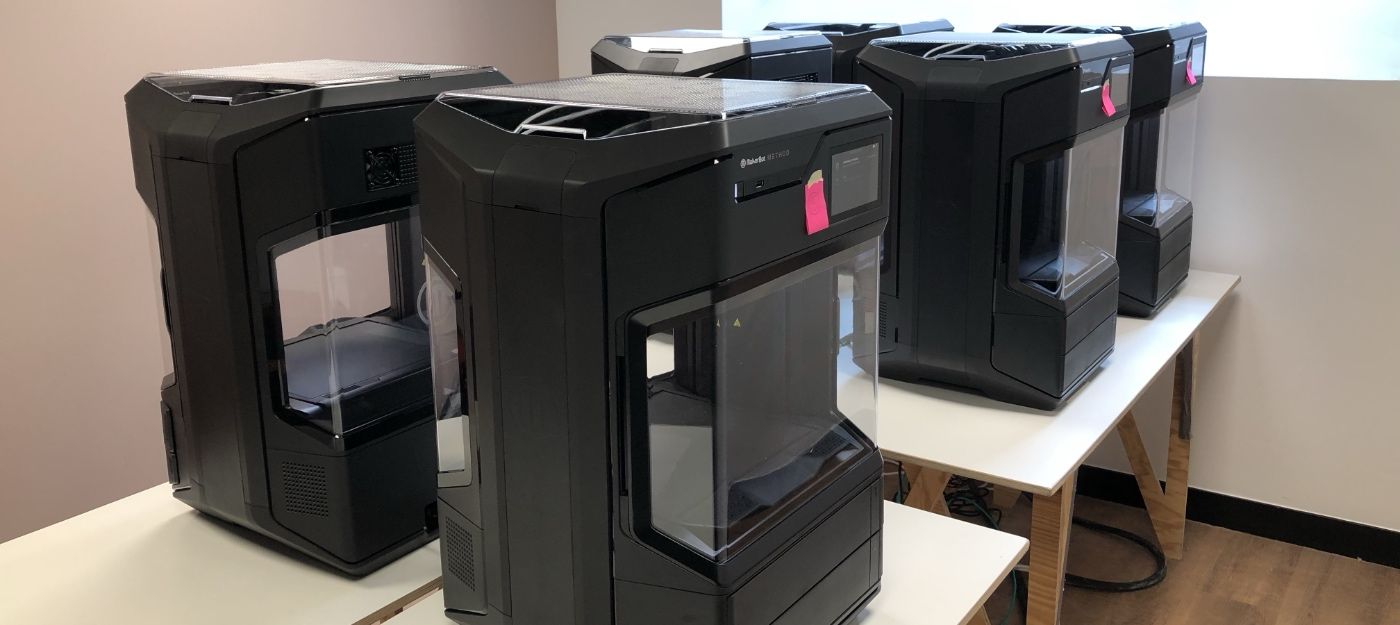
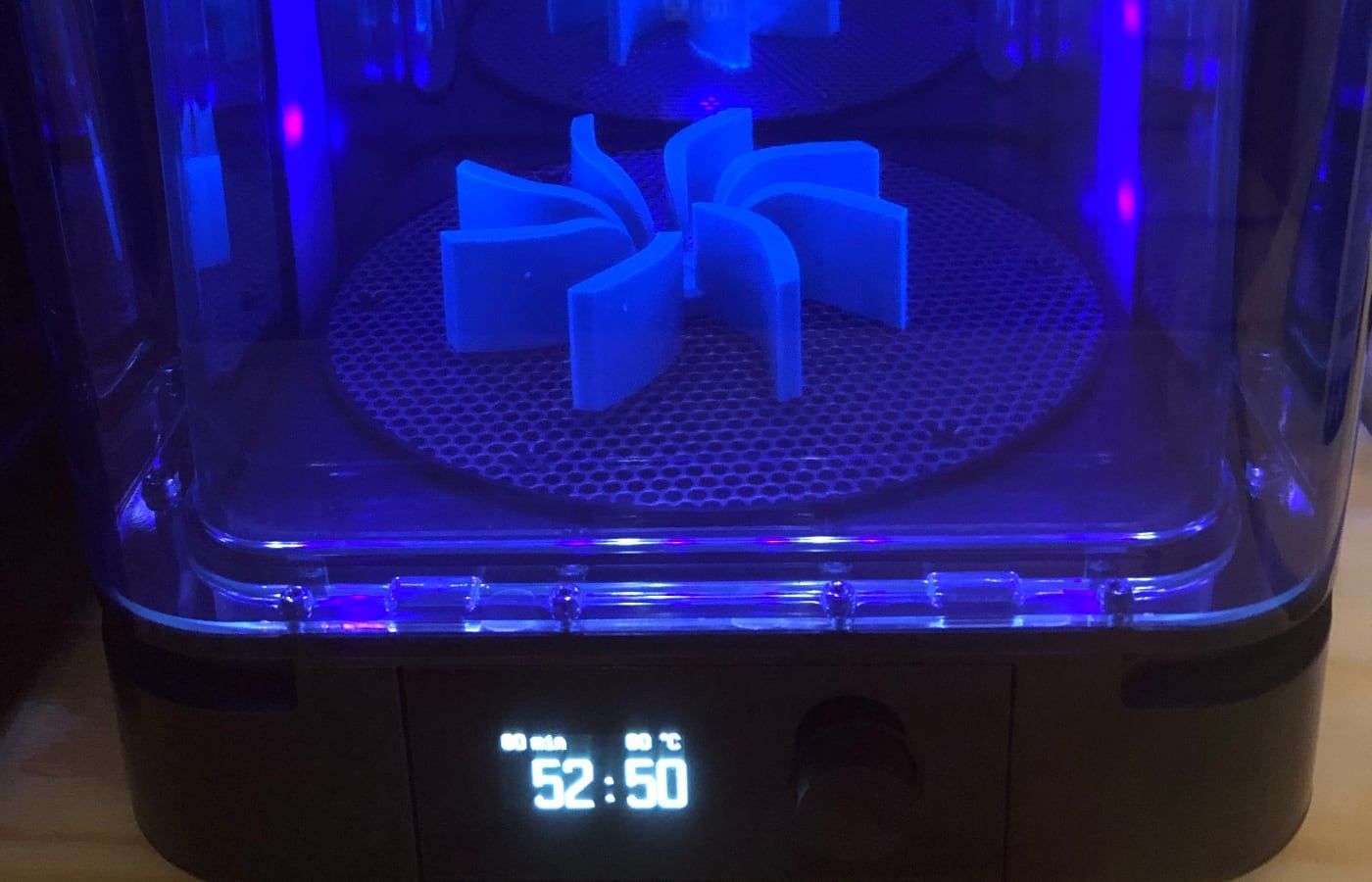
Going back to the drawing board
Our first design, although flawed, led to important design decisions regarding the overall architecture of the ventilator.
Thinking with first principles, our ventilator needed to:
- Produce air: using a blower turbine;
- Control air: a way to precisely control the air flow going in and out of the ventilator (to/from patient lungs);
- Filter air: components to filter the air going in and out of the ventilator (you do not want to blow Covid out of the ventilator);
- Measure air: sensors to measure the air pressure in the circuit (too high a pressure could blow the patient’s pulmonary alveolus);
- Provide power: batteries for backup power, and an AC-DC converter;
- Orchestrate it all: a board running our software and ventilation control algorithms, connected to hardware buttons and a small display for a user to adjust ventilation settings and check for the measured pressures;
Luckily, we quickly figured out that we had to stop trying to 3D-print our own components, and instead rely on manufactured parts. This led us to completely reconsider our ventilator design around the 29th of March 2020. That is, 11 days after we started the project.
Final design (current one)
As the project quickly got more serious, qualified engineers joined the project thereafter, which brought in some new fresh ideas in fields where we lacked professional knowledge (namely, electronics and mechanical design). In the long run, you really cannot rely on what hobbyists produce.
We kept our blower-based design, but removed the 3D-printed valve-based circuit and replaced it with flexible pipes, made of a medical-grade plastic (biocompatible). To control the air that was allowed to go towards the lungs, or outwards from the lungs, we designed a pinch valve system, driven by a Faulhaber Brushless DC servomotor, capable of handling a lifetime of 1M+ respiratory cycles (if not way more; to give you an idea of what is required, a Covid patient must be ventilated for approximately 2 weeks, that’s about 500k breathing cycles).
This new pinch valve system has the simple task of pressing (pinching) the flexible air pipe to a certain degree. As we can measure the resulting air pressure instantly, we can feed this back to the control loop and pinch a bit more or a bit less by rotating the motor very precisely to a new target angle, until we stabilize to the desired air pressure in the pipe. We use a PID control algorithm for that, which is also what your car uses under the hood whenever you enable cruise mode. More engineering details on that will be provided in the next articles of this series.
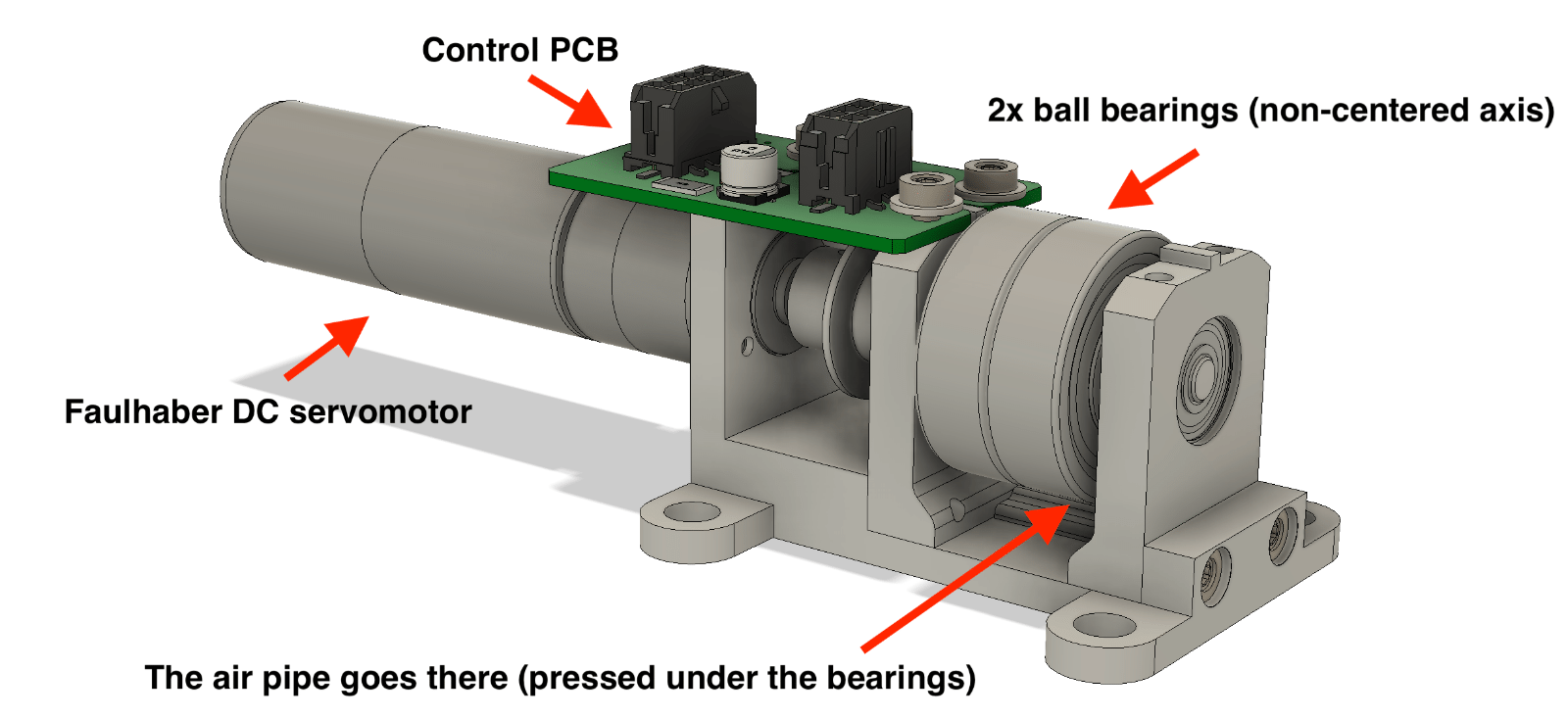
As we were building a pressure-controlled ventilator (also, more background on pressure and volume control will be provided in the next articles of the series), we needed pressure sensors that would feed instant pressure values measured in mmH20/cmH20 to our algorithm. Those pressure sensors are mounted on the custom motherboard PCB that we designed for the MakAir ventilator. That motherboard is including a STM32 chip, which is running our firmware, as well as a LoRa chip which can be used to transmit instant ventilation metrics wirelessly, to a central node eg. a monitoring room in the hospital (unused as of today).
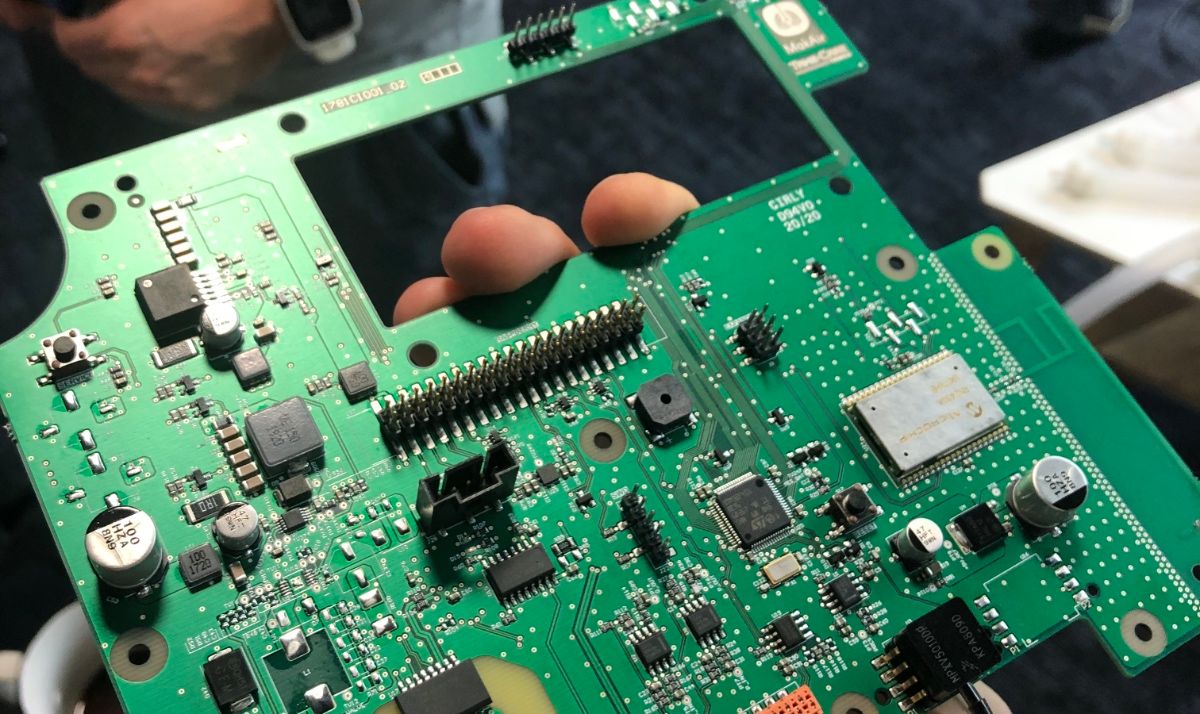
Our cornerstone work having been laid out on the firmware side with our ventilation algorithms, now we needed to provide a way for doctors and nurses to monitor the ventilation metrics in real-time on large modern display. That is when we introduced a second computing component to the ventilator: a control UI with a touchscreen, running on an ARM-powered board with a Linux system. We built a user interface software that connects to the motherboard using a serial connection, and speaks a common telemetry protocol to pull realtime ventilation data.
That way, the super-reliable yet simple embedded system that runs the sensitive ventilation algorithms (ie. the firmware), is completely isolated from the (probably) less-reliable ARM-based complex computer that runs the touch interface on Linux. Tesla did it in a similar way in their cars, by separating the drive computer from the multimedia computer (the large center display), which is a neat design choice regarding reliability & safety.
Note that, while this touchscreen is still working in pair with the hardware buttons as of today, we plan to migrate all user controls to be touch-only in the future. This makes internationalization of the user interface easier, as it becomes all software.
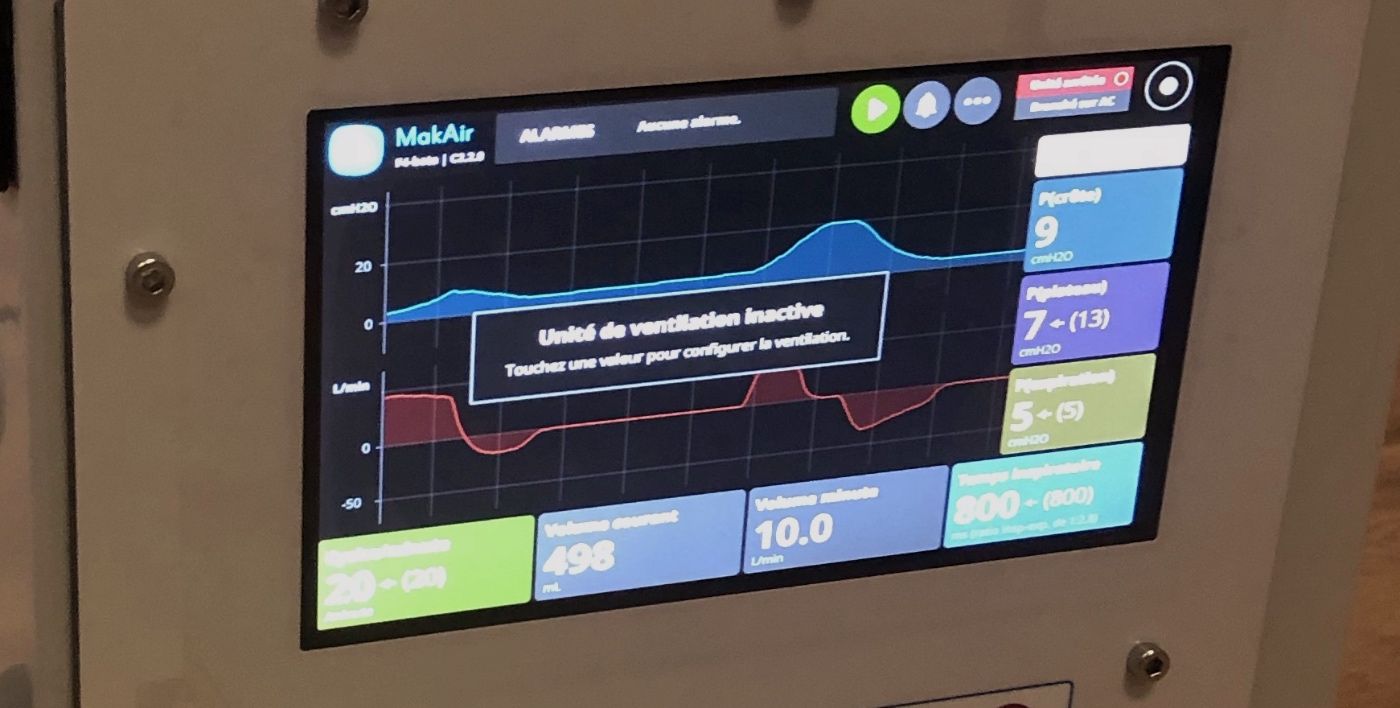
All those design changes & improvements led to a simpler and more reliable, mass-producible, ventilator. All components were fitted inside a large but strong plastic casing, that was extruded where eg. a touchscreen, buttons or air connectors needed to be mounted. This feels a bit like 90s computers to me, which is enjoyable to work with and repair as everything is reachable with bare hands.

Full version history
In order for the reader to understand how far we've came from during the project, I've compiled ordered pictures of each MakAir version: prototypes, production models and experiments (ie. the MakAir Mini), that our team has built during the project's 2 months.
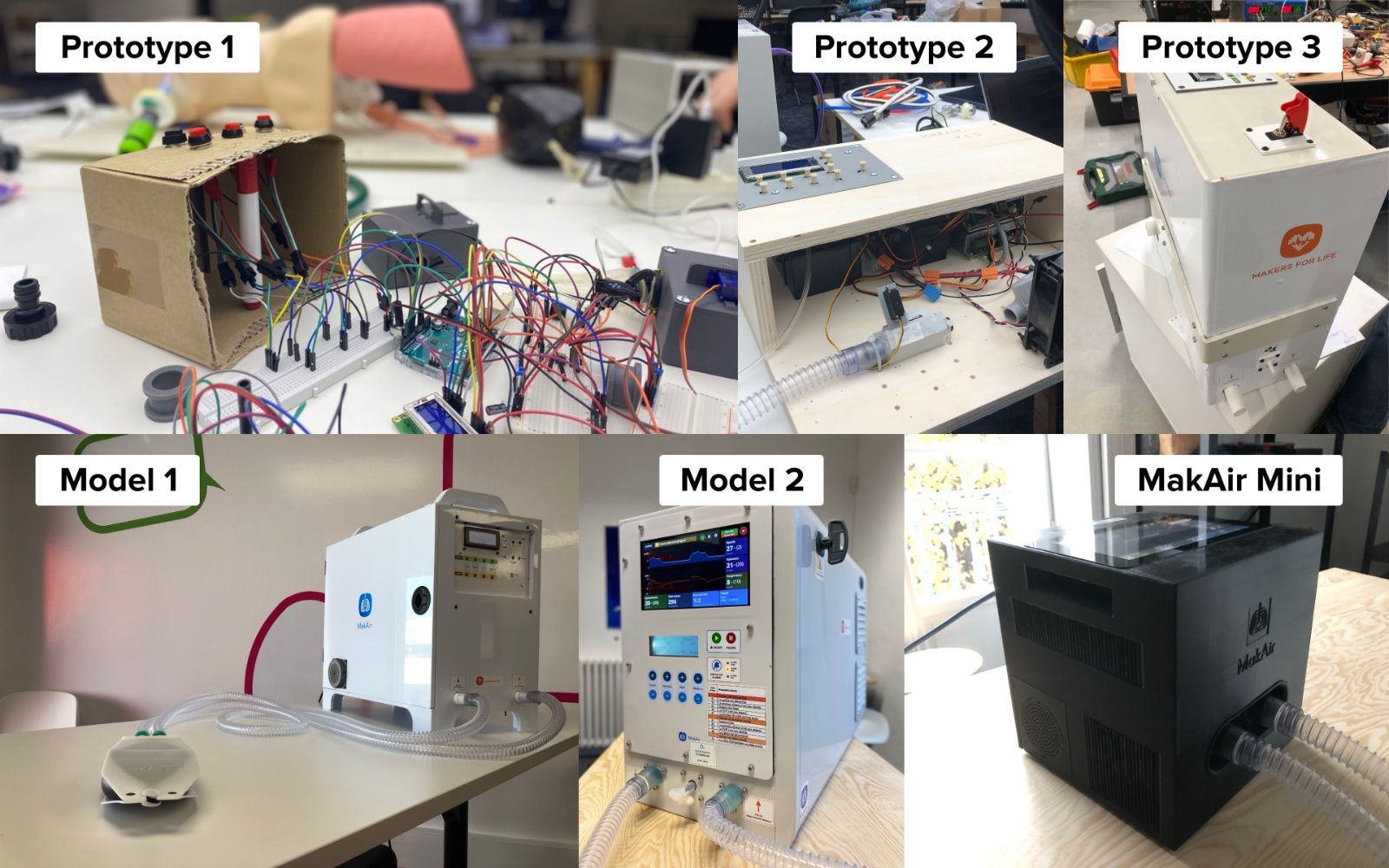
Project Milestones
For the purpose of keeping a record of important dates and milestones throughout the project, I made a list of each important milestone, with dates.
This can also help you capture how fast things have been going, as well as easily locate an hardware revision in time, based on each milestone that we achieved.
- 18th March 2020: the MakAir project begins in the offices of Crisp in Nantes, France. First prototype of the MakAir ventilator done there (“air transistor” valves-based);
- 22nd March 2020: the team of 3 moves from Crisp offices to a larger room in Le Palace in Nantes, France. The team quickly grew larger in the upcoming days (to around 10 engineers on-site). Second prototypes of the MakAir ventilator done there (pinch valves-based). Prof. Pierre-Antoine Gourraud joins and brings academic/medical credentials to the project;
- 23rd March 2020: universities, hobbyist and local companies like General Electric lend us an array of 3D printers so that we can speed up prototyping (mostly older MakerBot machines);
- 25th March 2020: we are getting officially supported by the French Army, which has been super-quick to respond to our needs and the needs of Covid-relief projects during the crisis;
- 28th March 2020: our collaboration with CEA Grenoble officially starts, with the delivery of 10 brand-new MakerBot Method printers to speed up prototyping and iterate faster (picked up from MakerBot warehouses in The Netherlands and delivered to France in record time). At the same time, we ship wooden prototype in a plane from Nantes to Grenoble, so that the CEA team can have a look at it;
- 31st March 2020: our lab is moved from Nantes to Grenoble in France, the whole team (20+ people) jumps on a 9 hours overnight bus trip from one side of France to the other. We get access to better prototyping and manufacturing facilities to work on the next steps of the project. This is also when we order all required parts (in the thousands!) to plan for the mass-manufacturing of our ventilator, using the colossal funding resources of CEA (which is state-backed);
- 3rd April 2020: first in-lab animal testing of our ventilator prototype for a 12h session, which was a success (on a pig which was dosed Curare in order to put it to sleep and deactivate natural lung breathing). The team was incredibly tense during the test, as this was the first time that a MakAir ventilator could either safe a life, or kill the animal. All went well, and the pig woke up after the test in a healthy condition;
- 6th April 2020: CEA’s plastic specialist partner delivers its new MakAir casing. We now have a proper, professional-looking casing in which our components can be fitted. Note that we are not using this casing design anymore, though it looks similar in shape to what we have in the current version;
- 8th April 2020: the manufacturing of 50 production units has started in the cleanroom of CEA Grenoble;
- 10th April 2020: 3 members of the MakAir team hop on another 9 hours overnight road trip from Grenoble to Brest, France, to bring 3 MakAir V1 ventilators to Erwan L’Her, a ventilation specialist in CHU Brest (a public hospital in Brest), with whom we are still collaborating and getting feedback from. He provided medical guidance from there on to the engineering team, in order for us to improve our ventilation algorithms. Note that an academic paper has also been redacted on how well the MakAir performs in comparison to other ventilators (in French);
- 15th April 2020: second live animal test, on the same pig, using the latest ventilator hardware and software. Success as well, we were less tense this time;
- 17th April 2020: job done at CEA Grenoble, the team is heading back to Nantes by bus, for yet another 9 hours trip. Setting the lab back in our initial location at Le Palace Nantes;
- 21st April 2020: our press coverage program started, in order to bring public awareness about the project. The team is juggling between journalists coming in, and improving MakAir hardware and software on the engineering side;
- 29th April 2020: first live prototype of our improved MakAir hardware with the touchscreen UI, displaying live ventilation graphs. The MakAir ventilator feels more alive than never before;
- Beginning of May 2020: the project scales down a bit as some volunteer engineer’s companies are re-opening, the core team keeps iterating on details of software and hardware, improving the touchscreen interface as well as ventilation algorithms. I am also working on a new casing design on my end, which was later canceled (CAD model available online);
- 20th May 2020: our team receives the third motherboard revision, which is the one we are still using as of today, featuring a STM32 SoC. This is around that time that Groupe SEB starts manufacturing the MakAir, using our latest hardware;
- 21st July 2020: clinical trials start in Nantes, on human patients. Unfortunately, they are using a deprecated MakAir revision, as there is always a huge lag between the clinical trial authorizations we receive from authorities, and our current state of the art in terms of engineering. The way it works, is that we submit an approval request which would certify a given hardware and software, frozen in time, which then only gets approved around a month later;
- August 2020: summer happens, everyone is exhausted, the project is taken to a pause on the engineering side, though Groupe SEB continues iterating on their manufacturing processes to mass-produce MakAir ventilators;
- October 2020: working on a new MakAir casing on my end, which I named MakAir Mini, with the goal of fitting all our hardware components inside a 20x20x20cm casing. The goal is to reduce cost and size, as this casing can be plastic-molded for around 5 EUR of plastic. That was quite a challenge, though I managed to achieve it after 2 assembly tries. The MakAir Mini casing CAD model can be viewed online, or in video;
- October to December 2020: with the second lockdown in France, the core team is getting back to work. Huge improvements were made on the firmware and touchscreen interface, with a new volume-controlled ventilation mode (adding to the existing pressure controlled mode), improved safety and a lot of new settings. Those improvements all bring MakAir toes to toes with existing professional ventilators on the market. Also, a ventilator simulator was designed, which allows the simulation of ventilation scenarios and physical behavior of the ventilator components, in a pure-digital environment (no atoms, just bits). Clinical trials are still ongoing at this point, in Nantes;
- February 2021: 2 MakAir ventilators with the latest hardware and software built in late 2020 are being shipped to Madagascar for use on patients (as part of a larger humanitarian effort);
Project Team & Contacts
I thought that it was important to keep a record of all most-active contributors throughout the project, as they can be contacted at a later point whenever a technical or medical question is raised on a topic.
As MakAir is not an incorporated organization, but rather a fuzzy decentralized collective (like a DAO on the blockchain), there is no central contact point. You should rather direct your questions to one of the individual contributors listed below, which are known to be the most active ones.
I’ve compiled a list of those contributors, categorized:
Overall project management:
- Quentin Adam, CEO at Clever Cloud. He helped grow the project from a team of 3 to 300+ contributors, through his vast personal/professional network;
- Baptiste Jamin, CEO at Crisp. He’s my co-founder at Crisp, and handled day-to-day problems, coordinating the engineering team and helping validate the ventilator on test equipment;
Firmware & ventilation algorithms:
- Gabriel Moneyron, CEO at Cooprint. He rebuilt the firmware nearly from scratch, re-implementing all the ventilation algorithms (pressure and volume controlled);
- David Sferruzza, works at Startup Palace. He designed the serial telemetry protocol that connects the firmware to the touchscreen software, and built the initial firmware source code;
User-interface & touch-screen:
- Valerian Saliou, CTO at Crisp. That’s me. I’ve built the control UI software, used to display realtime ventilation graphs and control ventilation settings;
Mechanical parts & manufacturing:
- Clément Niclot, mechanical engineer at RTSYS. He designed various mechanical components in the MakAir, like the currently-used pinch valve part;
- Eliott Vincent, software engineer at Crisp. He helped coordinate with all our suppliers & manufacturers, and build each one of our prototypes in the lab;
Motherboard, PCB design & electronics:
- Vincent Le Cunff, electronics engineer at Tronico. He designed our current motherboard design, running the firmware on a STM32 SoC;
- Pierre Papin, software engineer at SenX. He handled day-to-day electronic needs, designed some PCB designs, tested power components, batteries, etc.;
Medical questions & clinical trials:
- Pierre-Antoine Gourraud, professor & researcher at University of Nantes. He provided all the medical background and connections to the medical world (CHU Nantes);
Closing Notes
If you have been reading this article to the end, I’d like to thank you for that. This article was the first of a series on the MakAir story, providing insider details on the project, medical knowledge on the state of the art of mechanical ventilation, as well as in-depth engineering explanations on how we designed our ventilator algorithms and electronics. The overall goal of this series of articles is to build the legacy of the MakAir project.
Worldwide pandemics due to respiratory virus infections might, according to earlier predictions, become more common in the future. If another respiratory pathogen like SARS-CoV happens again in the future, causing tension on traditional ventilator manufacturing & supply chains, those articles should help teams worldwide kickstart their crisis ventilator project even faster than we did.
I’d be glad if those articles help someone in the future avoid the mistakes we made while we learnt how to design ventilators. We were among the first to design open-source ventilators, starting from nothing, as all existing commercial ventilator designs are closed-source/proprietary at the time. This would help response teams save precious time, ultimately leading to preserving life.
Also, I’m always available to answer questions, please ask them in the comments section of this article!
🇫🇷 Written from Nantes, France.
